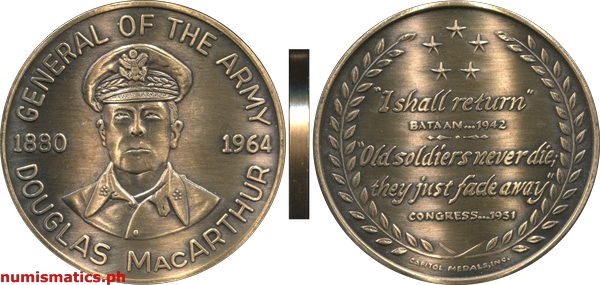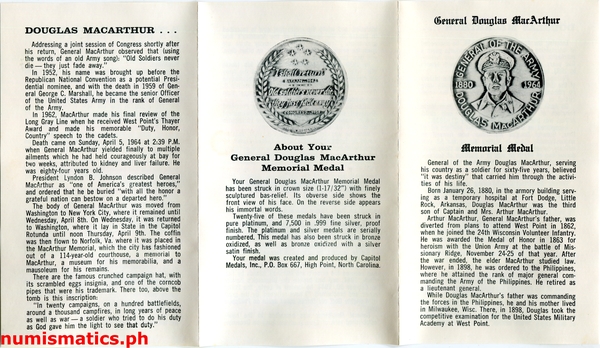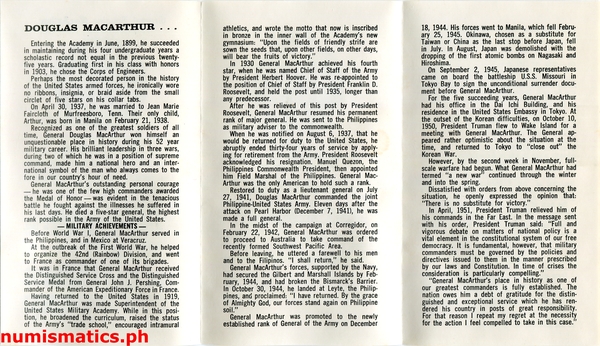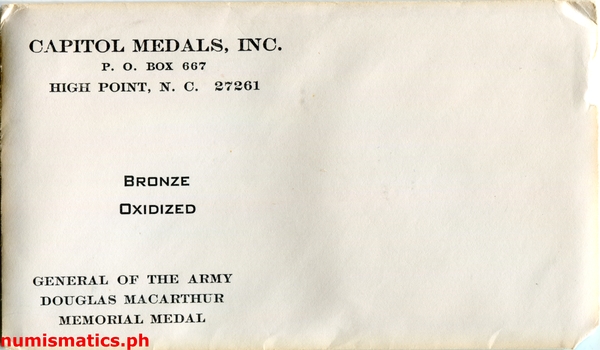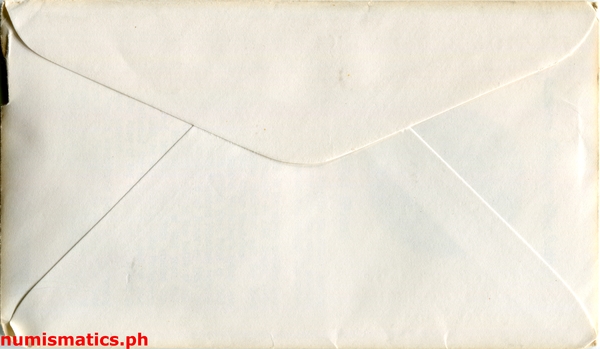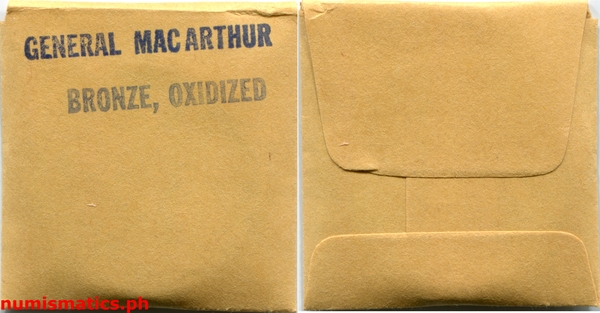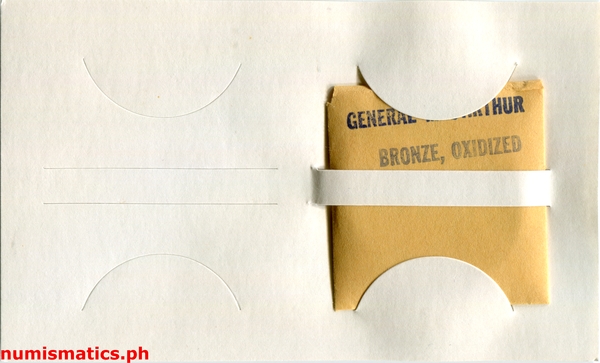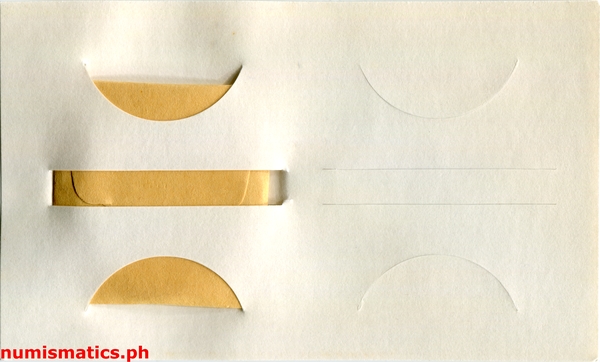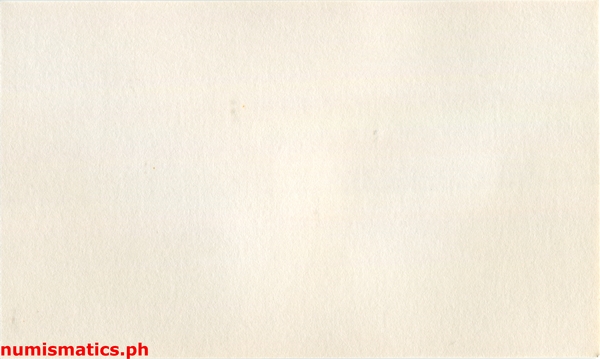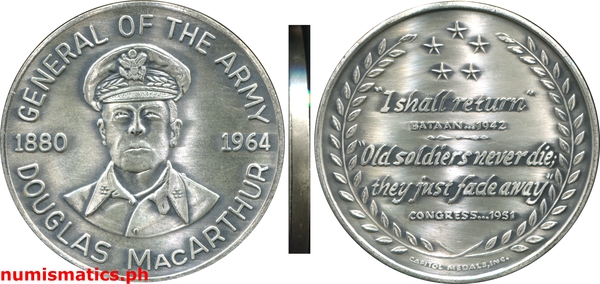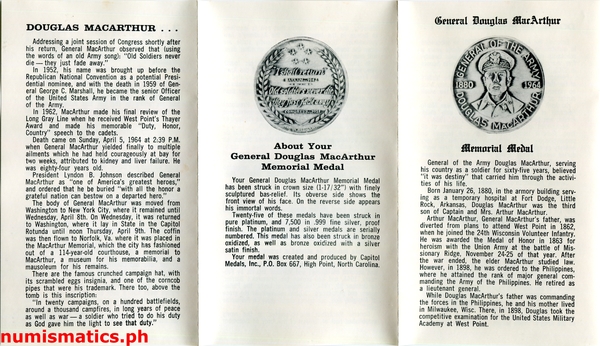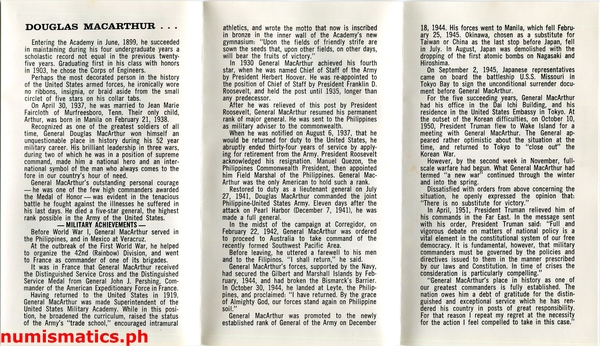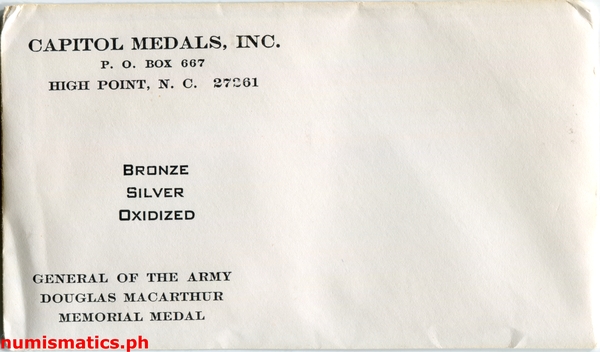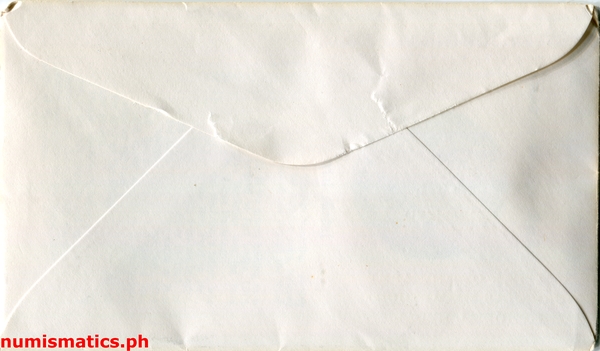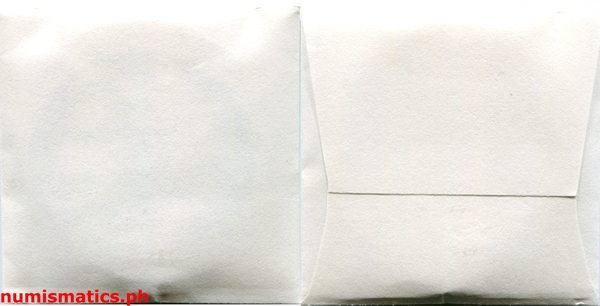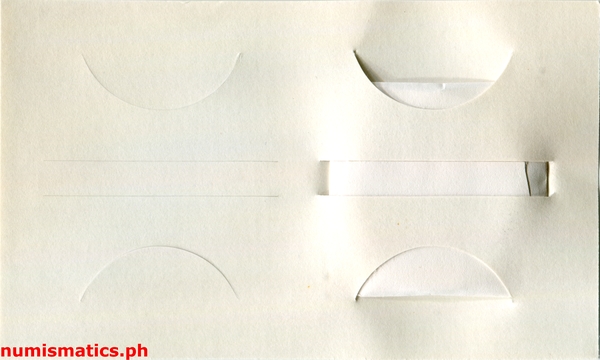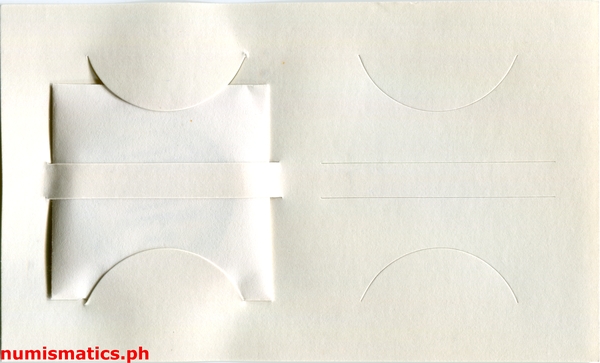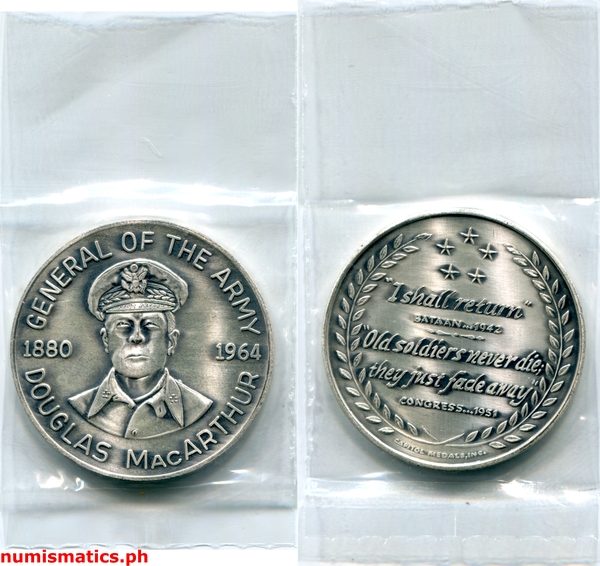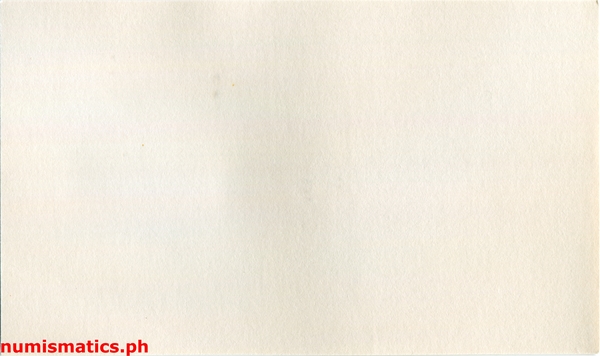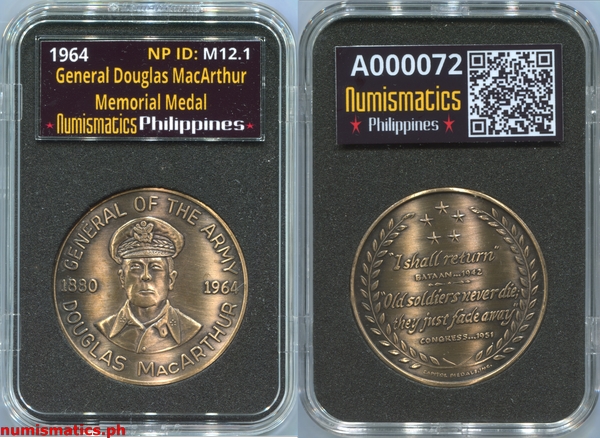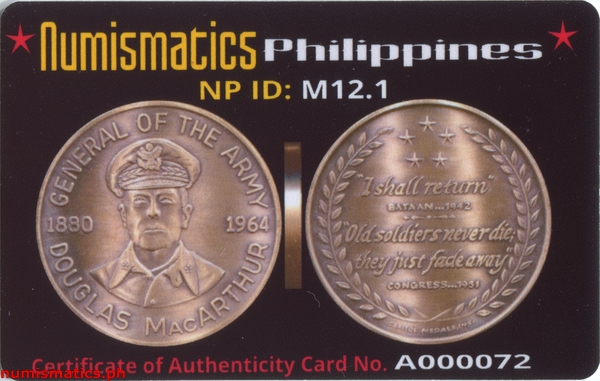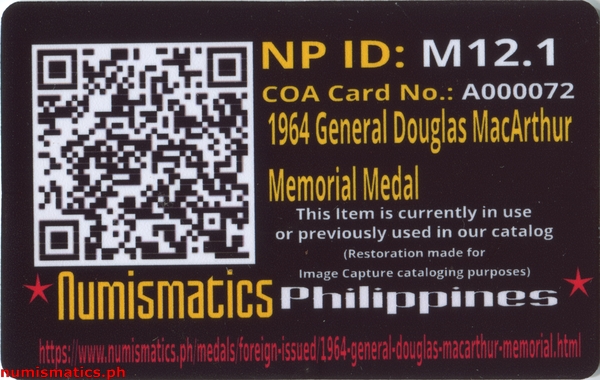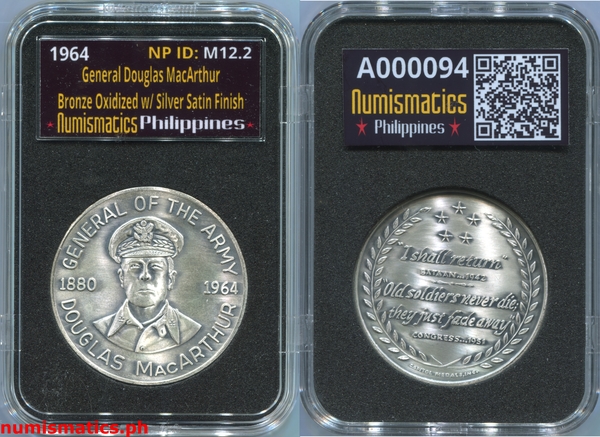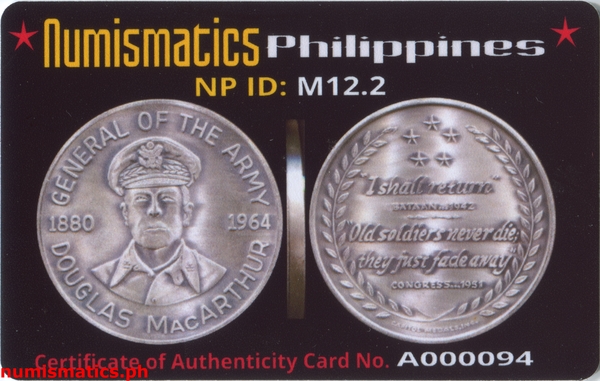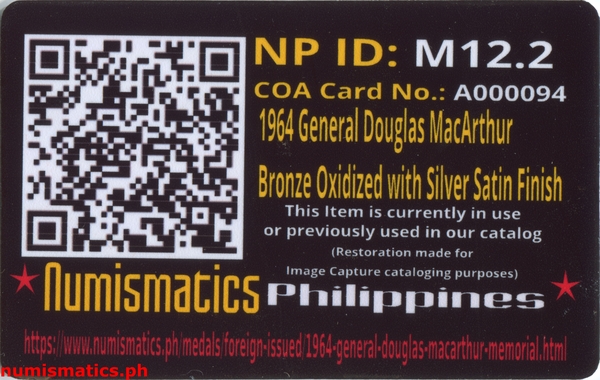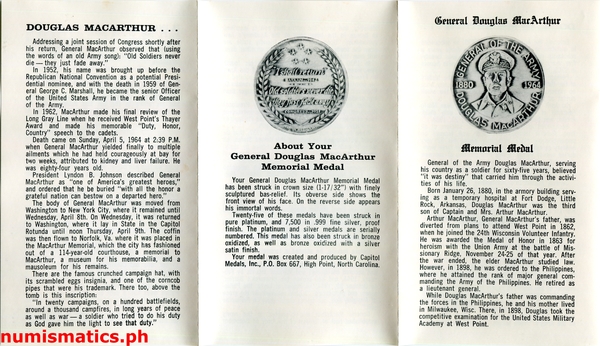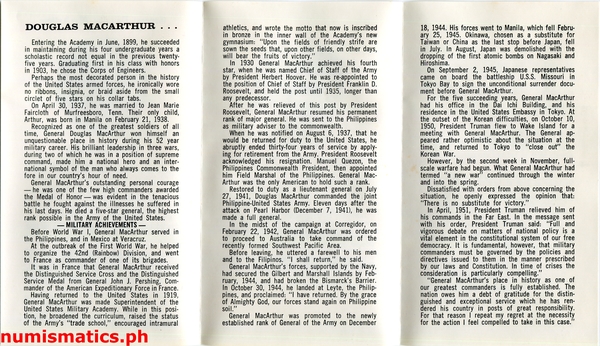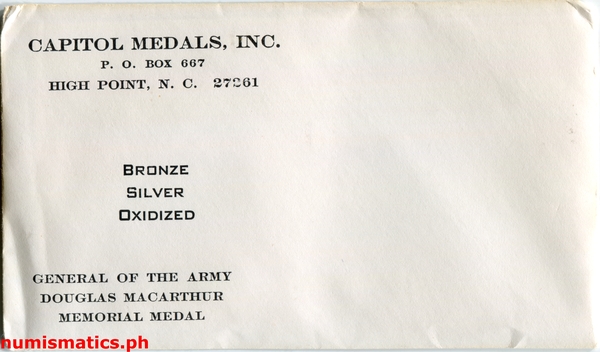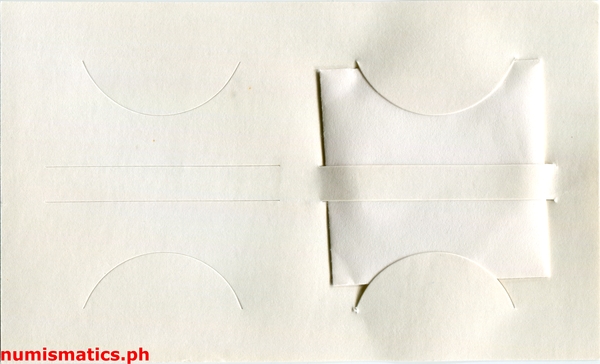Obverse
Portrait of General Douglas MacArthur "" "" "General of the Army"
Reverse
5 Stars "I shall return" "Bataan..." "Old soldiers never die; they just fade away" "Congress..." "Capitol Medals, Inc."
Literature
General Douglas MacArthur
Memorial Medal
General of the Army Douglas MacArthur, serving his country as a soldier for sixty-five years, believed "it was destiny" that carried him through the activities of his life.
Born , in the armory building serving as a temporary hospital at Fort Dodge, Little Rock, Arkansas, Douglas MacArthur was the third son of Captain and Mrs. Arthur MacArthur.
Arthur MacArthur, General MacArthur's father, was diverted from plans to attend West Point in , when he joined the 24th Wisconsin Volunteer Infantry. He was awarded the Medal of Honor in for heroism with the Union Army at the battle of Missionary Ridge, November 24-25 of that year. After the war ended, the elder MacArthur studied law. However, in , he was ordered to the Philippines, where he attained the rank of major general commanding the Army of the Philippines. He retired as a lieutenant general.
While Douglas MacArthur's father was commanding the forces in the Philippines, he and his mother lived in Milwaukee, Wise. There, in , Douglas took the competitive examination for the United States Military Academy at West Point.
Entering the Academy in , he succeeded in maintaining during his four undergraduate years a scholastic record not equal in the previous twenty-five years. Graduating first in his class with honors in , he chose the Corps of Engineers.
Perhaps the most decorated person in the history of the United States armed forces, he ironically wore no ribbons, insignia, or braid aside from the small circlet of five stars on his collar tabs.
On , he was married to Jean Marie Faircloth of Murfreesboro, Tenn. Their only child, Arthur, was born in Manila on .
Recognized as one of the greatest soldiers of all time. General Douglas MacArthur won himself an unquestionable place in history during his 52 year military career. His brilliant leadership in three wars, during two of which he was in a position of supreme command, made him a national hero and an international symbol of the man who always comes to the fore in our country's hour of need.
General MacArthur's outstanding personal courage — he was one of the few high commanders awarded the Medal of Honor —was evident in the tenacious battle he fought against the illnesses he suffered in his last days. He died a five-star general, the highest rank possible in the Army of the United States.
— MILITARY ACHIEVEMENTS —
Before World War I, General MacArthur served in the Philippines, and in Mexico at Veracruz.
At the outbreak of the First World War, he helped to organize the 42nd (Rainbow) Division, and went to France as commander of one of its brigades.
It was in France that General MacArthur received the Distinguished Service Cross and the Distinguished Service Medal from General John J. Pershing, Commander of the American Expeditionary Force in France.
Having returned to the United States in 1919, General MacArthur was made Superintendent of the United States Military Academy. While in this position, he broadened the curriculum, raised the status of the Army's "trade school," encouraged intramural athletics, and wrote the motto that now is inscribed in bronze in the inner wall of the Academy's new gymnasium: "Upon the fields of friendly strife are sown the seeds that, upon other fields, on other days, will bear the fruits of victory."
In General MacArthur achieved his fourth star, when he was named Chief of Staff of the Army by President Herbert Hoover. He was re-appointed to the position of Chief of Staff by President Franklin D. Roosevelt, and held the post until , longer than any predecessor.
After he was relieved of this post by President Roosevelt, General MacArthur resumed his permanent rank of major general. He was sent to the Philippines as military adviser to the commonwealth.
When he was notified on , that he would be returned for duty to the United States, he abruptly ended thirty-four years of service by applying for retirement from the Army. President Roosevelt acknowledged his resignation. Manuel Quezon, the Philippines Commonwealth President, then appointed him Field Marshal of the Philippines. General MacArthur was the only American to hold such a rank.
Restored to duty as a lieutenant general on , Douglas MacArthur commanded the joint Philippine-United States Army. Eleven days after the attack on Pearl Harbor (), he was made a full general.
In the midst of the campaign at Corregidor, on , General MacArthur was ordered to proceed to Australia to take command of the recently formed Southwest Pacific Area.
Before leaving, he uttered a farewell to his men and to the Filipinos. "I shall return," he said.
General MacArthur's forces, supported by the Navy, had secured the Gilbert and Marshall Islands by , and had broken the Bismarck's Barrier. In , he landed at Leyte, the Philippines, and proclaimed: "I have returned. By the grace of Almighty God, our forces stand again on Philippine soil."
General MacArthur was promoted to the newly established rank of General of the Army on . His forces went to Manila, which fell . Okinawa, chosen as a substitute for Taiwan or China as the last stop before Japan, fell in July. In August, Japan was demolished with the dropping of the first atomic bombs on Nagasaki and Hiroshima.
On , Japanese representatives came on board the battleship U.S.S. Missouri in Tokyo Bay to sign the unconditional surrender document before General MacArthur.
For the five succeeding years, General MacArthur had his office in the Dai Ichi Building, and his residence in the United States Embassy in Tokyo. At the outset of the Korean difficulties, on , President Truman flew to Wake Island for a meeting with General MacArthur. The General appeared rather optimistic about the situation at the time, and returned to Tokyo to "close out" the Korean War.
However, by the second week in November, full-scale warfare had begun. What General MacArthur had termed "a new war" continued through the winter and into the spring.
Dissatisfied with orders from above concerning the situation, he openly expressed the opinion that: "There is no substitute for victory."
In , President Truman relieved him of his commands in the Far East. In the message sent with his order. President Truman said: "Full and vigorous debate on matters of national policy is a vital element in the constitutional system of our free democracy. It is fundamental, however, that military commanders must be governed by the policies and directives issued to them in the manner prescribed by our laws and Constitution. In time of crises the consideration Is particularly compelling."
"General MacArthur's place in history as one of our greatest commanders is fully established. The nation owes him a debt of gratitude for the distinguished and exceptional service which he has rendered his country in posts of great responsibility. For that reason I repeat my regret at the necessity for the action I feel compelled to take in this case."
Addressing a joint session of Congress shortly after his return, General MacArthur observed that (using the words of an old Army song): "Old Soldiers never die —they just fade away."
In , his name was brought up before the Republican National Convention as a potential Presidential nominee, and with the death in of General George C. Marshall, he became the senior Officer of the United States Army in the rank of General of the Army.
In , MacArthur made his final review of the Long Gray Line when he received West Point's Thayer Award and made his memorable "Duty, Honor, Country" speech to the cadets.
Death came on Sunday, when General MacArthur yielded finally to multiple ailments which he had held courageously at bay for two weeks, attributed to kidney and liver failure. He was eighty-four years old.
President Lyndon B. Johnson described General MacArthur as "one of America's greatest heroes," and ordered that he be buried "with all the honor a grateful nation can bestow on a departed hero."
The body of General MacArthur was moved from Washington to New York City, where it remained until Wednesday, . On Wednesday, it was returned to Washington, where it lay in State in the Capitol Rotunda until noon Thursday, . The coffin was then flown to Norfolk, Va. where it was placed in the MacArthur Memorial, which the city has fashioned out of a 114-year-old courthouse, a memorial to MacArthur, a museum for his memorabilia, and a mausoleum for his remains.
There are the famous crunched campaign hat, with its scrambled eggs insignia, and one of the corncob pipes that were his trademark. There too, above the tomb is this inscription:
"In twenty campaigns, on a hundred battlefields, around a thousand campfires, in long years of peace as well as war — a soldier who tried to do his duty as God gave him the light to see that duty."
About Your
General Douglas MacArthur
Memorial Medal
Your General Douglas MacArthur Memorial Medal has been struck in crown size (1-17/32") with finely sculptured bas-relief. Its obverse side shows the front view of his face. On the reverse side appears his immortal words.
Twenty-five of these medals have been struck in pure platinum, and 7,500 in .999 fine silver, proof finish. The platinum and silver medals are serially numbered. This medal has also been struck in bronze oxidized, as well as bronze oxidized with a silver satin finish.
Your medal was created and produced by Capitol Medals, Inc., P.O. Box 667, High Point, North Carolina.
Note
This medal was struck by Capitol Medals Inc. in , after the general died. The platinum and silver medals are serially numbered. It features his portrait and two of his famous quotations: "I shall return," in reference to the Philippines, and, "Old soldiers never die; they just fade away."
